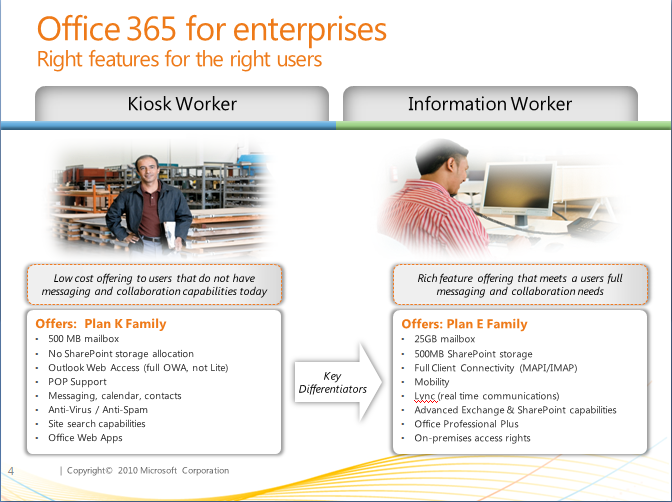Microsoft's Office 365: A guide to the coming plans and prices

Microsoft is expected to "turn on" its Office 365 cloud platform in June this year. Thousands of customers and partners have been beta testing the Microsoft-hosted Exchange Online, SharePoint Online and Lync Online suite for the past few months.

Office 365 isn't a one-size-fits-all offering. There are a lot of different plans at a variety of prices. There is a P Plan for small/mid-size business (SMB) users. There are two K Plans for "kiosk workers" (formerly known, in Microsoft parlance as "deskless workers"). There are four E Plans for information workers. Additionally, Office 365 users can opt to add the Office 2010 Professional Plus software and pay for it on a per-month, subscription basis.
I've been asking Microsoft for a couple of months for details on the various Office 365 SKUs. Finally, this week, the Softies came through. With Microsoft's help, I've distilled the Office 365 offerings down to six slides, which, in my opinion, makes things a little less complex and more understandable.
Slide Show: Microsoft Office 365: Is there a plan and pricepoint that's right for you?
(The Directions on Microsoft folks recently did a Webcast to help users wade through the Office 365 SKUs and plans, as well. )
In short, the P Plan is aimed at price-sensitive SMB users who may be thinking about going Google, as one Microsoft partner, who requested anonymity, explained to me. The E Plans are aimed at enterprise users -- both the current BPOS customers whom Microsoft is encouraging to move to Office 365, as well as new cloud customers. K Plans are also aimed at enterprise users, but those who don't need all the bells and whistles provided by the E Plans.
Microsoft also has updated its Enterprise Agreement licensing terms to offer its volume licensing users what is known as a User Subscription License.
"In essence Microsoft with the new agreements is granting customers maximum flexibility to switch from the traditional Enterprise Agreement which has predominantly been based around the On-premise software deployment paradigm to any variety of none, some, most, or all running via Online Services or running on premise," explained the aforementioned partner.
Customers get the right to switch from a standard EA to an EA for Online Services, without having to pay for it until the first anniversary date of their Enterprise Agreements. This could allow some custoemrs to get months of Office 365 usage without having to pay for it until their EAs come due.
Microsoft's not always known for being flexible in terms of its licensing options -- or fast to react to the competition. But Microsoft really needs Office 365 to take hold with its customers and partners if it plans to make its cloud push successful. While there definitely are a lot of moving parts with Office 365's SKUs and pricing plans, complexity means choice, in this case.
More Office 365 coverage:
Ten More Tidbits About Microsoft's Office 365 Play
Sorry, Folks: Office 365 Is Not Office in the Cloud
Microsoft Details Packaging, Pricing for Office 365 for Education